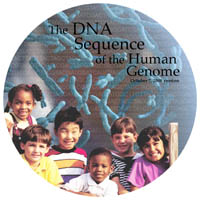
January 22, 2001
UCSC researchers produce human genome CD for the National Millennium Time Capsule
By Tim Stephens
Safely housed inside the National Millennium Time Capsule for the next 100 years,
alongside Ray Charles's sunglasses and a piece of the Berlin Wall, is a CD-ROM disk
produced by UCSC researchers that contains the DNA sequence of the human genome.
 |
| This image is imprinted on the CD-ROM of the human genome sequence included in the National Millennium Time Capsule. Photo: Courtesy of the National Human Genome Research Institute |
One of the crowning achievements of 20th-century science, the human genome sequence represents all of the genetic instructions for a human being. The completion of a working draft of the human genome sequence was announced in June 2000 by the leaders of the Human Genome Project, a public consortium involving more than 1,000 scientists in six countries.
UCSC researchers played a key role in this achievement, creating a powerful new computer program to assemble fragmented data from the major sequencing labs into a coherent sequence. David Haussler, professor of computer science and an investigator with the Howard Hughes Medical Institute, is leading UCSC's involvement in the Human Genome Project. Biology graduate student Jim Kent is also a major contributor, having written the software code needed to assemble the working draft of the genome. He has also designed a dynamic web browser to help researchers extract useful information from the genome sequence and also to add data that will contribute to its scientific utility and medical relevance. UCSC's Human Genome Browser is publicly available at http://genome.ucsc.edu/.
"In my mind, the end of this millennium is a unique point in time because it is the first moment in which a species on this planet has viewed its own genome," Haussler said. "I am profoundly honored to have been able to play a role in this event, and to have the working draft of that genome recorded in the millennium time capsule."
The White House Millennium Council asked former presidential and congressional medal winners from diverse fields of accomplishment, as well as students from across the country, to describe what they think represents America at the end of the 20th century and to express their hopes for the future. A CD-ROM of the human genome was suggested by James Watson, co-discoverer of the structure of DNA, who was awarded the National Medal of Science in 1997.
"[The human genome] will be biology's most important gift ever to human society, being the instruction book for human development and functioning," Watson said in a letter to the council.
Other events, ideas, and achievements of the 20th century represented in the time capsule include the sounds of Louis Armstrong, a photograph of U.S. troops liberating a concentration camp, women's rights, the electronics revolution, the dream of Martin Luther King Jr., landing on the Moon, and a model of the Liberty Bell.
Additional information about the National Millennium Time Capsule can be found on the web at http://www.nara.gov/nara/pressrelease/nr01-20.html.